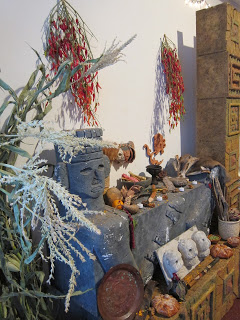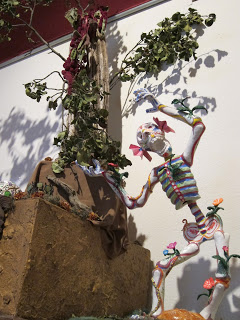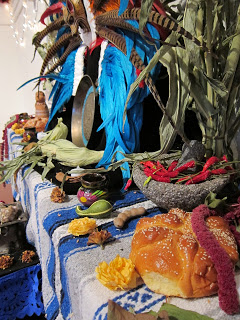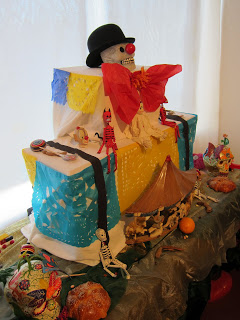Through Nov. 11, Miracle is pleased to display in our Zócalo community space adjacent to the lobby an exhibit of ofrendas (altars) created by FusionArte collective of local Latino artists in celebration of Día de los muertos (Day of the Dead). The exhibit, curated by Pepe Moscoso, is free and open to the public one hour prior to and during the intermission of each performance of Miracle Theatre Group’s original, bilingual production Raíz, plus weekdays by appointment for student groups.
“The Day of the Dead reaches into the ancient history of Mexico, when the spirits of dead relatives are allowed to return to the mortal world to visit loved ones,” says Moscoso, who is the host of a Spanish-language radio program on KBOO and a visual artist himself. “It connects us with the cycles of life, intertwined rituals, customs, offerings that reflect the Mexican’s perception toward death in a way that’s entertaining, even joking,” says Moscoso, who is the host of a Spanish-language radio program on KBOO and a visual artist himself.
The altar exhibit is curated and produced by Pepe Mosoco with the help of Rodolfo Valentín, William Hernández, Alejandra Schimpfoessl, Armando Olveda and the Consulate of Mexico in Portland. Also on display will be Day of the Dead-themed paintings by Jaime Nava & Alejandro Ceballos.
Indigenous Deities: This altar represents how from ancient times man has been creating beings and gods with extraordinary powers to assuage the fears of the phenomena of the world around them. The indigenous cultures of Mesoamerica had polytheistic beliefs, which meant that they worshipped a variety of deities.
They relied on these gods for everything. They gave form to the universe, defining nature and each of its elements. The gods manifested themselves in different ways, such as through the action of time and its effects, knowledge of the material world and the perception of spirituality, the concepts of life and death, the ephemeral and the eternal, the human and the divine. This symbolization of the deities not only explained these phenomena, but also helped indigenous communities to understand their purpose in the cycle of life.
Deidades Indígenas: este altar representa como desde tiempos remotos el hombre ha ido creando seres y dioses con extraordinarios poderes para mitigar su asombro a los fenómenos del mundo. Las culturas indígenas de Mesoamerica tenían creencias politeístas que significa adorar a varios dioses. De estos dioses dependía todo. Daban forma al universo definiendo a la naturaleza en cada una de sus elementos. Se manifestaban de distintas maneras como en la acción del tiempo y sus efectos, la conciencia de lo material y la percepción de lo espiritual, los conceptos de la vida y de la muerte, lo efímero y eterno, lo divino e humano. Esta simbolización de las deidades no solo explicaba estos fenómenos, sino que también ayudaba a las comunidades indígenas a entender el propósito de su ciclo de vida.
Indigenous World View: This altar portrays the conceptualization and ideas about space and time in the image of a structured, stratified universe. Ancient peoples envisioned the gods as giving form to a universe of thirteen heavens above, the earth located in the center, and the nine underworlds at the tail. This vision of the cosmos presents thirteen superimposed heavens, descending vertically from the highest of nocturnal space where various gods reside. The earth, situated beneath the thirteen heavenly levels and above the nine underworlds, is considered the land of the ephemeral, the place of work and suffering. The underworlds consist of nine levels through which the dead spend four years traveling, confronting tests and dangers while their bodies dissipate until reaching the state of pure soul.
Cosmovisión Indígena: Este altar trata la conceptualización y las ideas referentes al espacio y al tiempo en la imagen de un universo estructurado, mediante una parcelación. Las creencias de los pueblos ancestrales conceptualizaban a los dioses dando forma al universo en Trece Cielos que ocupaban la cabeza, la tierra se asentaba en el centro y los Nueve Inframundos se ubicaban en su cola. En esta visión cosmogónica presenta trece cielos superpuestos cuya verticalidad deciende desde lo alto del espacio nocturno y que permite ubicar el hábitat de varios dioses. La tierra ubicada bajo los trece estratos celestes y sobre los nueve inframundos es considerada como el sitio de lo efímero, lugar donde ocurren los trabajos y sufrimientos. Los inframundos consisten en nuevo estratos por donde los muertos realizan un viaje póstumo que dura cuatro años y a través del cual deben afrontar pruebas y peligros que durante ese proceso se van descarnando o desmaterializando hasta conseguir el estado puro del alma
Indigenous Peoples: This altar is about the peoples that embrace their ethnic identity particular to the territory that they inhabit, those who have been there long enough to be considered native. They are present in different parts of the world, maintaining their ancient traditions and customs that are distinct from the modern world. Among the indigenous customs, we have a lot of traditions tied to the changing of the seasons. One of the most significant is giving thanks to the Mother Earth for all of the natural resources received during the year. There are rituals and dances, filled with aesthetic and theological symbolism. The typical clothing, the music, the food, and the decorations are some of the elements that form each people’s identity and create their own cultural heritage.
Pueblos Indígenas: este altar trata sobre las comunidades que asumen una identidad étnica, originaria del territorio que habitan, cuya presencia es lo suficientemente prolongada y oriunda (originaria). Están presentes en distintas partes del mundo, manteniendo sus tradiciónes milenarias y costumbres que son muy distintas al mundo moderno. Dentro de las costumbres indígenas tenemos muchas tradiciones que se van desarrollando durante el cambio de las estaciones. Uno de las mas significativas es el agradecimiento a la madre tierra por todos los recursos naturales recibidos durante el año. Se realizan rituales y danzas con una gran cantidad de simbolismos estéticos y teológicos. Las vestimentas tipicas, la música, la comida, y las decoraciones son algunos de los elementos de la identidad de cada pueblo y crean su propio acervo cultural.
The circus: The altar of “los santos inocentes” (the “innocent saints”, or those who have died as children) is dedicated to the magical world of the circus. This spectacle represents an important part of human culture, a noble venture constructed throughout many centuries, practically since man started to record its achievements, discoveries, ideas, and beliefs. The circus is a show that attracts the young and old, and within it combines the magic of event is combined with the adventurous spirit of the protagonists. The raising of the tents, the animals, the thunderous brass bands, all come together to create an incomparable atmosphere. Animal acts are one of the oldest types of performances in the circus, and the use of animals of prey, such as tigers and lions, capture the attention of the little ones.
El circo : El altar de los santos inocentes esta dedicado al magico mundo del circo. Este espectaculo representa una importante parte de la cultura humana, una noble empresa construida a lo largo de muchos siglos, prácticamente desde que el hombre empezó a registrar sus hazañas, sus descubrimientos, sus ideas y sus creencias. Un show que atrae a grandes y a pequeños, y en él se combina la magia de la función con el propio espíritu aventurero de los protagonistas. El montaje de las carpas, los animales, las estruendosas bandas de viento, todo se une para crear una atmósfera incomparable. La interpretación con animales son uno de los espectaculos más antiguos que existen en el circo. El empleo de animales de presa, como tigres y leones, crea la afinación de los niños.




